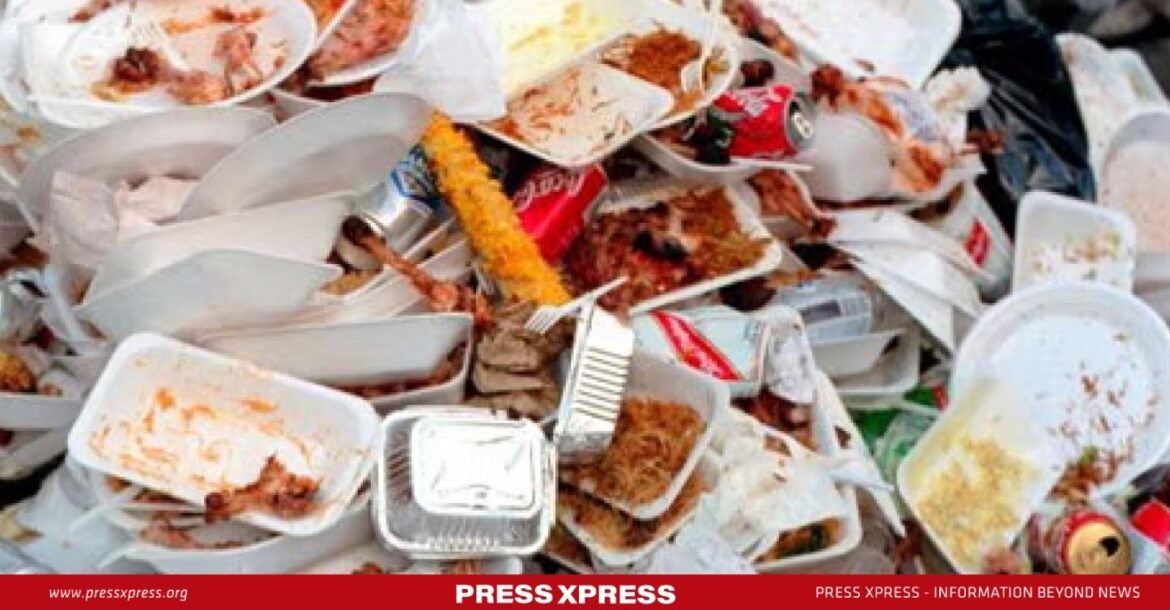This wasteful trend exacerbates global hunger and environmental degradation
An estimated 82kg of food is wasted annually by Bangladeshis, a significantly higher amount compared to prosperous nations like the USA, Russia, and China, according to the “Food Waste Index Report 2024” released by the United Nations Environment Program (UNEP) based in Nairobi.
The report highlights that households in Bangladesh discard 14.10 million tons of food each year, marking an increase from 2021. This global issue, as emphasized by UNEP Executive Director Inger Andersen, leads to millions facing hunger presently due to unnecessary food waste.
You can also read: Understanding Bangladesh’s External Debt Situation
Moreover, Andersen notes that this phenomenon not only poses a significant development concern but also inflicts considerable environmental and wildlife costs. Contrary to common belief, the report reveals that food waste is not solely confined to affluent nations, with average levels of household food waste differing by only 7kg per capita across high-income, upper-middle, and lower-middle-income countries.
The UN projections indicate that in 2022, nearly 1 billion meals were wasted daily worldwide, alongside 783 million individuals enduring hunger, with food insecurity affecting one-third of the global population.
The collaborative research conducted in 2024 with WRAP presents the most accurate global evaluation of food waste within retail and consumer sectors. It guides governments on enhancing data collection methods and suggests optimal strategies for shifting focus from monitoring to reducing food waste.
Food Waste Overview in Bangladesh
Based on findings from the “Food Waste Index Report 2024,” households in Bangladesh discard approximately 14.10 million tonnes of food each year, marking a significant increase from the previous assessment. In contrast, individuals in wealthier nations such as the United States (73kg), Netherlands (59kg), and Japan (60kg) dispose of comparatively lesser amounts of food annually. For instance, an estimated 82kg of food is squandered per person annually in Bangladeshi households, highlighting a concerning trend of escalating food wastage. This contrasts starkly with the figures reported in 2021, where the annual household food wastage in Bangladesh was estimated at 10.62 million tonnes, with individuals discarding 65kg of food per year on average.
This waste constitutes a significant portion, ranging from 68.3% to 81.1%, of the overall municipal solid waste (MSW) in the country. The generation of food waste in Bangladesh is primarily attributed to various sources such as restaurants, agricultural activities, household disposal, and social gatherings. Despite the considerable volume of food waste generated, there is a lack of comprehensive regulations addressing this issue, leading to significant losses in food production and consumption. These losses include harvest losses, distribution losses, and consumer waste, collectively contributing to the overall food waste rate. Specifically, in restaurants, consumers bear responsibility for 56% of the waste generated post-meal preparation and cooking. Over the years 2016 and 2017, the food production and consumption cycle resulted in approximately 23.69 million tons of food waste.
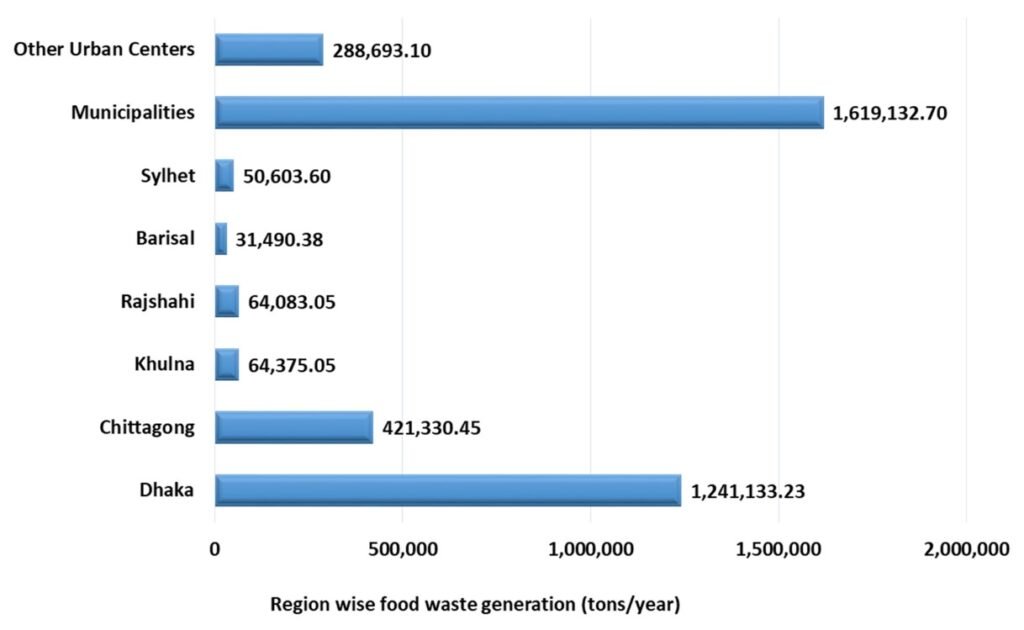
In terms of regional distribution, Dhaka exhibits the lowest proportion of MSW attributed to food waste, accounting for 68.3% of the total, whereas Barisal has the highest proportion at 81.1%. Dhaka alone discards around 1,241,133.23 tons of food wasted annually, while in Chittagong, an industrial city, the estimated food wastage rate is approximately 421,330.45 tons per year. These estimates encompass variations in food waste rates across seasons, encompassing both dry and wet seasons typical of tropical climates.
Food Waste Stats: South Asia
In the realm of South Asian nations, households in India discard 55kg of food per individual every year, with Sri Lanka and Bangladesh tallying 76kg, Pakistan 130kg, Afghanistan 127kg, and Nepal 93kg. Notably, Maldives households top the list by squandering 207kg of food per person yearly, marking the highest rate in the area.
Conversely, Bhutanese households demonstrate the lowest food wastage in the region, amounting to merely 19kg per person annually.
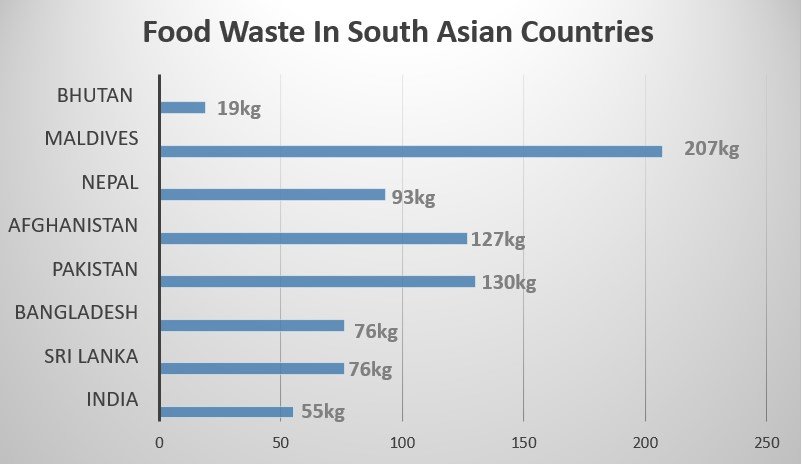
Global Food Waste Scenario
“Food waste is a global tragedy. Millions will go hungry today as food is wasted across the world,”
– Inger Andersen, Executive Director of UNEP

According to the Food Waste Index Report released by the U.N. Environment Programme on March 27, 2024, approximately 19% of the food produced worldwide in 2022, equivalent to roughly 1.05 billion metric tons, went to waste. This report, co-authored by UNEP and the Waste and Resources Action Programme (WRAP), a global charity, indicates a significant increase in the number of countries participating in the index compared to the initial report in 2021. In 2019, the first report estimated that 17% of globally produced food, or 931 million metric tons (1.03 billion tons), was squandered.
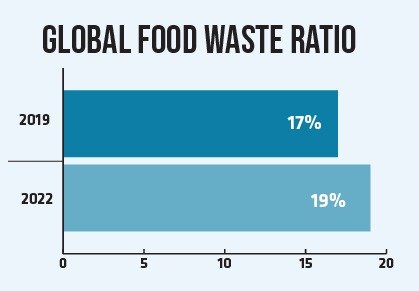
The analysis, which delved into data from various countries encompassing households, food services, and retailers, unveiled that each individual discards approximately 79 kilograms (around 174 pounds) of food annually, translating to at least 1 billion meals wasted daily across the globe. The majority of this wastage, accounting for 60%, originates from households, while food service establishments contribute around 28%, and retailers approximately 12%.
This revelation comes amidst a backdrop where 783 million people worldwide grapple with persistent hunger, exacerbating food crises in numerous regions.
The issue of food wastage extends beyond mere sustenance concerns, bearing significant environmental repercussions tied to production processes, including the utilization of land and water resources for agricultural endeavors and the resultant greenhouse gas emissions, notably methane, which has contributed roughly 30% to global warming since pre-industrial times.
In fact, food loss and waste contribute to 8 to 10 percent of the world’s greenhouse gas emissions, positioning it as the third-largest emitter after China and the U.S. if treated as a singular entity.
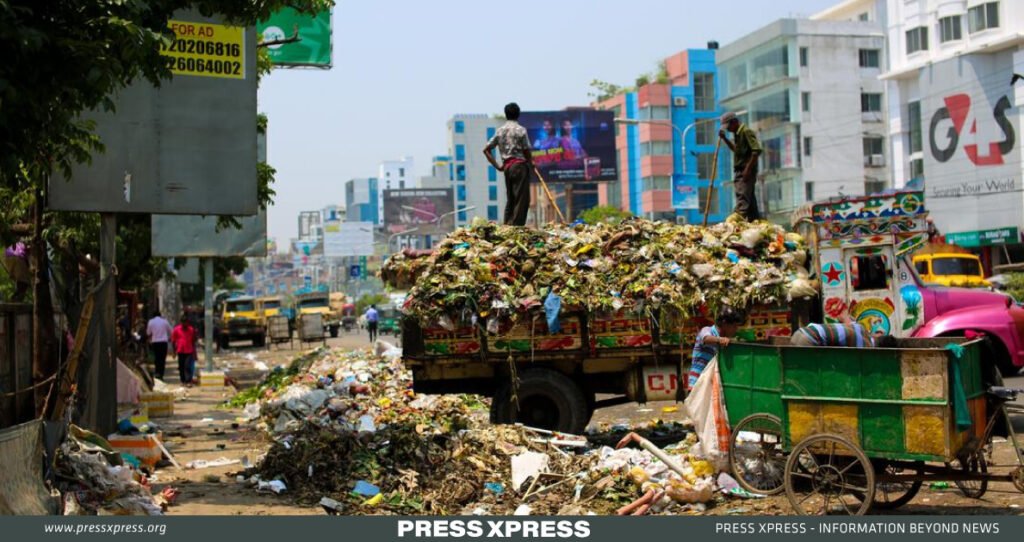
Combatting Global Food Waste
To address the global food waste crisis, concerted efforts are imperative.
First, education campaigns must be launched at all levels to instill awareness about the consequences of food waste and promote responsible consumption practices.
Governments should enact and enforce policies to incentivize food conservation, such as tax breaks for food donations and regulations to limit overproduction.
Collaborations between stakeholders including governments, NGOs, and businesses are vital to implement efficient food distribution systems that redirect surplus food to those in need.
Additionally, investing in technology for better storage, transportation, and preservation of food can minimize losses along the supply chain. Encouraging sustainable farming practices and promoting the use of imperfect produce can also mitigate waste at the source. Ultimately, fostering a cultural shift towards valuing food and reducing excess consumption is fundamental to combatting this global challenge.
In conclusion, the “Food Waste Index Report 2024” emphasizes Bangladesh’s alarming food wastage, significantly surpassing rates in affluent nations. This wasteful trend exacerbates global hunger and environmental degradation. Collaborative efforts, including education, policy enactment, and technological innovations, are imperative to combat this crisis and foster a culture of responsible consumption worldwide.

